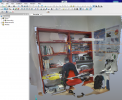Faro Scenect and dynamic point cloud extraction using Kinect
My personal review
 These days I'm testing my brand new Microsoft Kinect with this amazing free software by Faro. Scenect in fact is a Scene LT clone which embeds some Kinect drivers by PrimeSense and OpenNI. Even if my lab at University is waiting for Kinect for Windows supply from Microsoft, I bought myself a Kinect sensor in its XBOX360 version. Differences are not so massive (Kinect for Windows is intended for PC usage, so lenses can focus beginning from 40cm. while the XBOX release needs at least 80cm.) and Scenect supports both hardware devices.
These days I'm testing my brand new Microsoft Kinect with this amazing free software by Faro. Scenect in fact is a Scene LT clone which embeds some Kinect drivers by PrimeSense and OpenNI. Even if my lab at University is waiting for Kinect for Windows supply from Microsoft, I bought myself a Kinect sensor in its XBOX360 version. Differences are not so massive (Kinect for Windows is intended for PC usage, so lenses can focus beginning from 40cm. while the XBOX release needs at least 80cm.) and Scenect supports both hardware devices.
The purpose of my post is to spare some comments an a promising real time technology, aimed at dynamic indoor 3D capturing with not GPS driven and very low-cost hardware.
Some days ago Microsoft released Kinect for Windows SDK 1.7 including the amazing Kinect Fusion module, meant for point cloud extraction. This SDK is very much interesting, I'll give it a try in the very next future with my humble C# skills. However, real time point extraction is resource-demanding, and new classes and libraries are in need of powerful machines.
Scenect still does not rely on these new drivers, however GPU power is paramount the same way. I tested Scenect version 5.2.100.32597 64bits on different machines (trial period is restricted to 29 days, but a free licence, bound to the ethernet address can be requested to Faro). All tested PCs run Windows 7 64bits Enterprise Edition and they have these specs:
| Machine brand | CPU type | GPU type | Available RAM |
| Apple iMac (early 2009) | Intel Core 2 Duo @2.66GHz | NVIDIA GeForce 9400M | 8.0 GB |
| Apple MacBookPro (late 2011) | Intel core i7 @2.20GHz | AMD Radeon HD 6750M | 4.0 GB |
| Dell Precision T3500 | Intel dual Xeon @2.40GHz | Nvidia Quadro FX3800 | 24.0 GB |
| Dell Precision T1650 | Intel core i7 @3.40GHz | Nvidia Quadro 2000 | 16.0 GB |
The installation process was flawless on every PC, even if I recommend to copy installation files straight on an NTFS partition on Apple hardware running Windows in BootCamp mode. Scenect installs Kinect drivers for both existing versions together with ASUS Xtion specific drivers.
But be careful! New SDK 1.7 from Microsoft installs newer drivers making OpenNi and PrimeSense conduits pretty useless. So a working machine has to be imagined either as a developer's bench or as a user's one: in other words, no third party application software if you plan to code yourself for your device using the latest framework.
Scenect has the graphic user interface identical to Scene and it is able to capture in real time point cloud taking advantage of Kinect sensors. The magic is a combination of digital photogrammetry through a simple CMOS sensor and depth mapping produced by an IR emitter/receiver. Data are merged through GPU into a single stream (I will be much more specific in a scientific paper that I'm going to prepare soon).
In fact, the GPU is the core element of the tracking system: Nvidia Quadro boards had remarkable performance during live capture, while "more human" hardware led to frequent loss of tracking. Kinect compares different pictures taken at a frequency of 30Hz. with 640x480 resolution. Even the CPU is important: best results were obtained using high frequency i7 processors.
Nevertheless Scenect is still not mature, or I was not so talented in using it. Plain surfaces are not correctly recognized, neon lights indoor affect good results, tracking can be easily lost and closed captions without inertial measurement units are nearly impossible. Point clouds are noisy and edges are not clearly defined, but I come from laser scanning using active technology, so I'm pretty much hard to please!
Anyway there is a brilliant aspect: Kinect SDK could lead to a widespread programming activity, implying better results even in next Scenect release. For now, Scenect is very good at capturing point clouds dynamically with decent measurement capabilities, but the method is tricky and not so robust.
Un commento
Info
Dal 2004 questo piccolo angolo di rete raccoglie gli interessi di ricerca e i lavori di sperimentazione digitale di Simone Garagnani in materia di cultura geek, ma soprattutto di Building Information Modeling, rilievi digitali ad alta risoluzione e computer graphics legata al mondo dell'architettura, dell'ingegneria e delle costruzioni. TC Project, è presente anche sul social network Facebook.
Welcome to these pages that host since 2004 Simone Garagnani's personal blog, a collection of nerd notes and geek experiences focused sometimes on Building Information Modeling, terrestrial laser scanning, digital photogrammetry and computer graphics applied to the AEC world. The TC Project is also available on Facebook.
Segui le attività in TC Project: Registrazione
Follow TC Project activities: Registration/login
Ultimi commenti
Trevor Dwyer (VIC-20 The friend…): Hi there, I feel your pain on updates and the internet not being the same these days – well since 199…SiliconSimon (Cray-1 - The home…): If someone is interested in my little Cray’s files, please PM me since I do not often read comments o…
SiliconSimon (Cray-1 - The home…): Of course Mike, I sent you a PM!
Robert (Cray-1 - The home…): If it’s possible, I would love to get the files from you for this project. I have a Cray-1 chip sitti…
Mike (Cray-1 - The home…): Are the files still available?
MojaMonkey (SGI VW540 @ TC La…): Hi Simon? This is a long shot but I was wondering if you have a copy of the SGI drivers required to…











Uno o più commenti sono in attesa di approvazione.